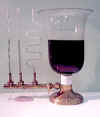
 SM084
Equilibrium conditions for a liquid
circa 1905 Hydrostatics
SM084
Equilibrium conditions for a liquid
circa 1905 Hydrostatics
For a liquid to
remain at rest in a vessel the following two conditions must be
satisfied.
(a)
Its surface must everywhere be perpendicular to the resultant of
the forces acting on the liquid molecules.
(b)
Every molecule of the mass of the liquid must be subject in every
direction to equal and opposite forces.
Now when there are
communicating vessels of different shapes filled with liquid there will
be equilibrium when the above conditions are met in each of the vessels.
Taking a section of the vessel, the pressure acting downwards is
equal to that acting upwards.
This pressure is equal to the weight of a column of liquid whose
base is the section being considered and whose height is the distance of
the centre of gravity of this section to the surface of the liquid.
Therefore, any horizontal plane in the liquid will have a
resultant force acting downward, only proportional to the height of the
plane.
It follows that whatever the shape of the vessel each level of
liquid will be the same height from the base.

![]()
 Museum
Museum
![]()
 SM084
Equilibrium conditions for a liquid
SM084
Equilibrium conditions for a liquid![]()